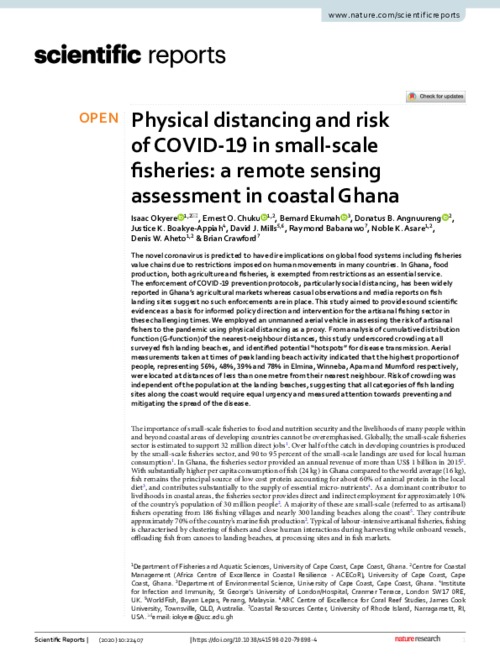Please use this identifier to cite or link to this item:
https://hdl.handle.net/20.500.12348/4490
Physical distancing and risk of COVID-19 in small-scale fisheries: A remote sensing assessment in coastal Ghana
| dc.creator | Okyere, I. | en_US |
| dc.creator | Chuku, E. | en_US |
| dc.creator | Ekumah, B. | en_US |
| dc.creator | Angnuureng, D. | en_US |
| dc.creator | Boakye-Appiah, J. | en_US |
| dc.creator | Mills, D.J. | en_US |
| dc.creator | Babanawo, R. | en_US |
| dc.creator | Asare, N. | en_US |
| dc.creator | Aheto, D. | en_US |
| dc.creator | Crawford, B. | en_US |
| dc.date.accessioned | 2021-02-01T11:01:56Z | |
| dc.date.available | 2021-02-01T11:01:56Z | |
| dc.identifier.citation | Okyere, I. Chuku, E. O. Ekumah, B. et al. (2020). Physical distancing and risk of COVID-19 in small-scale fisheries: A remote sensing assessment in coastal Ghana. Scientific Reports, 10(1): 22407. | en_US |
| dc.identifier.issn | 2045-2322 | en_US |
| dc.identifier.uri | https://hdl.handle.net/20.500.12348/4490 | |
| dc.description.abstract | The novel coronavirus is predicted to have dire implications on global food systems including fisheries value chains due to restrictions imposed on human movements in many countries. In Ghana, food production, both agriculture and fisheries, is exempted from restrictions as an essential service. The enforcement of COVID-19 prevention protocols, particularly social distancing, has been widely reported in Ghana’s agricultural markets whereas casual observations and media reports on fish landing sites suggest no such enforcements are in place. This study aimed to provide sound scientific evidence as a basis for informed policy direction and intervention for the artisanal fishing sector in these challenging times. We employed an unmanned aerial vehicle in assessing the risk of artisanal fishers to the pandemic using physical distancing as a proxy. From analysis of cumulative distribution function (G-function) of the nearest-neighbour distances, this study underscored crowding at all surveyed fish landing beaches, and identified potential “hotspots” for disease transmission. Aerial measurements taken at times of peak landing beach activity indicated that the highest proportion of people, representing 56%, 48%, 39% and 78% in Elmina, Winneba, Apam and Mumford respectively, were located at distances of less than one metre from their nearest neighbour. Risk of crowding was independent of the population at the landing beaches, suggesting that all categories of fish landing sites along the coast would require equal urgency and measured attention towards preventing and mitigating the spread of the disease. | en_US |
| dc.format | en_US | |
| dc.language | en | en_US |
| dc.publisher | Springer Nature | en_US |
| dc.rights | CC-BY-4.0 | en_US |
| dc.source | Scientific Reports;10,(2020) | en_US |
| dc.subject | coronavirus | en_US |
| dc.subject | value-chains | en_US |
| dc.subject | food-production | en_US |
| dc.subject | Fish | en_US |
| dc.title | Physical distancing and risk of COVID-19 in small-scale fisheries: A remote sensing assessment in coastal Ghana | en_US |
| dc.type | Journal Article | en_US |
| cg.contributor.crp | Fish | en_US |
| cg.contributor.funder | United States Agency for International Development | en_US |
| cg.coverage.country | Ghana | en_US |
| cg.coverage.region | Western Africa | en_US |
| cg.subject.agrovoc | policies | en_US |
| cg.subject.agrovoc | risk assessment | en_US |
| cg.subject.agrovoc | food systems | en_US |
| cg.subject.agrovoc | small-scale fisheries | en_US |
| cg.subject.agrovoc | unmanned aerial vehicles | en_US |
| cg.subject.agrovoc | covid-19 | en_US |
| cg.subject.agrovoc | physical distancing | en_US |
| cg.contributor.affiliation | WorldFish | en_US |
| cg.contributor.affiliation | James Cook University, ARC Centre of Excellence for Coral Reef Studies | en_US |
| cg.contributor.affiliation | University of Washington, College of the Environment, Marine and Environmental Affairs | en_US |
| cg.contributor.affiliation | University of Cape Coast | en_US |
| cg.contributor.affiliation | The University of Rhode Island | en_US |
| cg.identifier.status | Open access | en_US |
| cg.identifier.ISIindexed | ISI indexed | en_US |
| cg.contribution.worldfishauthor | Mills, D.J. | en_US |
| cg.description.theme | Resilient small-scale fisheries | en_US |
| dc.identifier.doi | https://dx.doi.org/10.1038/s41598-020-79898-4 | en_US |
| cg.creator.id | David Jonathan Mills: 0000-0003-0181-843X | en_US |
